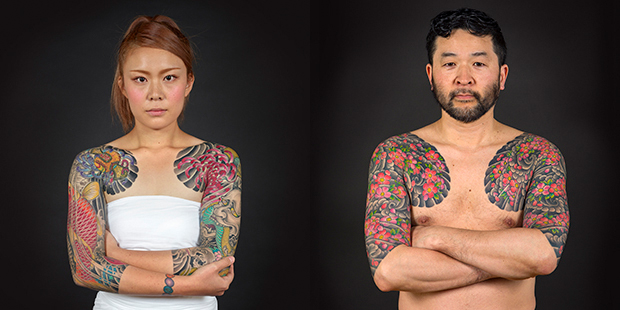 A suite of exhibitions and experiences that explore the art of tattoo, alongside themes of identity, self-expression, culture and community, Melbourne’s Immigration Museum presents Our Bodies, Our Voices, Our Marks on display from 24 May 2019.
A suite of exhibitions and experiences that explore the art of tattoo, alongside themes of identity, self-expression, culture and community, Melbourne’s Immigration Museum presents Our Bodies, Our Voices, Our Marks on display from 24 May 2019.
What stories do our bodies tell? That is the question Immigration Museum will be inviting visitors to explore when it opens the doors to its winter 2019 season Our Bodies, Our Voices, Our Marks. The suite of exhibitions and experiences includes two photography exhibits that look at the intersection of ancient and modern tattoo practices and a series of contemporary installations curated by Stanislava Pinchuk (Miso).
Perseverance: Japanese Tattoo Tradition in a Modern World explores the artistry and rich tradition of Japanese tattoos and their influence on modern tattoo culture in Japan. Facing negative stigma due to its association with the ‘yakuza’ – the country’s notorious mafia, this exhibition investigates how tattoo practice has persevered and looks to share its artistry, symbolism and the skill of its practitioners with wider communities.
Alongside this, Tatau: Marks of Polynesia looks at a 2,000-year-old art form that remains a cornerstone of Samoan culture throughout its global diaspora. It showcases the work of traditional tatau masters alongside that of emerging artists, and explores how this practice informs Samoan and other Polynesian identity and connection to culture.
Both exhibitions are organised by the Japanese American National Museum in Los Angeles, California and are toured internationally by Flying Fish Exhibits.
To offer local and contemporary perspectives on tattooing and identity, the Immigration Museum has commissioned Documenting the Body: Curated by Stanislava Pinchuk. This series of four installations will be dispersed throughout all three levels of the Immigration Museum and include works by Stanislava Pincuk, Zaiba Khan, Brook Andrew, Angela Tiatia and Paul Stillen.
In the central hallway, a series of portrait photographs and interviews will profile the practice of Melbourne tattoo artist Paul Stillen whose work is grounded in Australian and diverse cultural identities, artefact motifs and botanicals that reflect their wearer’s unique lives.
Upstairs in the first-floor foyer, Ancestral Worship by interdisciplinary artist Brook Andrew comprises a series of deck chairs printed with found ethnographic images of people that questions how bodies are represented historically, and how stories are told – beginning with Australian First Nations perspectives and expanding outward.
In Walking the Wall, Angela Tiatia uses video work to confront Samoan cultural taboo by revealing her sacred ‘malu’ (female thigh tattoo) as a way to challenge the traditional rules placed on femininity, while Immigration Granulation is a collaborative work by Stanislava Pinchuk and Zaiba Khan that explores tattooing and goldsmithing immigration paths back onto the bodies that made them in the Community Gallery.
“Curating under the Our Bodies, Our Voices, Our Marks umbrella has been a really wonderful challenge to extend the ideas offered by two blockbuster shows – and to give a local perspective into this global conversation,” said Stanislava Pinchuk. “As an artist, I’ve always seen tattooing as one of the most magic drawing practices that humans have.”
“Tattoos can cast us outside of society, or mark us as belonging – or both; it is a wonderful contradiction. But ultimately – they are a way to transform our bodies and connect to something larger and dream, which is such a fundamental part of what makes us all human.”
Kip Fulbeck, the exhibition artist and designer of Perseverance: Japanese Tattoo Tradition in a Modern World, will travel to Melbourne for the opening. He is a photographer and professor of art at the University of California, Santa Barbara and is himself extensively tattooed in the Japanese style. He said that the title of the show takes its name from the Japanese concept of ‘gaman’.
“Gaman is the idea that as an artist you strive and strive, refine and refine, push and push. It has been central to Japanese tattoo practice surviving and is also central to the relationship between tattooist and client,” said Fulbeck. “Full body tattoos take years to complete, and the pain is considerable. Extraordinary stamina is required to create these masterpieces of body art.”
Rohini Kappadath, General Manager of the Immigration Museum said the exhibition was an exciting continuation to the success of Love – which saw the museum welcome record-breaking numbers of visitors. “Our winter season Our Bodies, Our Voices, Our Marks reflects the Immigration Museum’s commitment to presenting experiences that foster cross-cultural understanding and human connection,” she said.
“Through the art of tattoo, and works and events that explore themes of identity and self-expression we invite people to consider what shapes us and how these understandings can be a powerful connector across communities.”
Our Bodies, Our Voices, Our Marks
Immigration Museum, 400 Flinders Street, Melbourne
Exhibition: 24 May – 6 October 2019
Entry fees apply
For more information, visit: www.museumsvictoria.com.au for details.
Image: photographs from Perseverance: Japanese Tattoo Tradition in a Modern World by Kip Fulbeck – organised by JANM and toured internationally by Flying Fish
